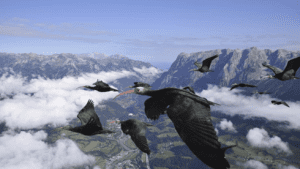TAG: GS 3: ECOLOGY AND ENVIRONMENT
THE CONTEXT: The distinctive northern bald ibis, hunted essentially to extinction by the 17th century, was revived by breeding and rewilding efforts over the last two decades.
EXPLANATION:
- The northern bald ibis, known for its striking black-and-iridescent green plumage, bald red head, and long curved beak, was once a common sight across North Africa, the Arabian Peninsula, and much of Europe.
- Hunted to near extinction by the 17th century, this distinctive bird is making a comeback, thanks to dedicated conservation efforts.
- However, these birds face a unique challenge—they do not instinctively know the migration routes.
- To overcome this, a dedicated team of scientists and conservationists has taken on the role of surrogate parents and flight instructors.
The Extinction and Reintroduction of the Northern Bald Ibis
- Historically, the northern bald ibis was a familiar bird across several regions, including southern Germany’s Bavaria.
- They were once even considered a delicacy.
- However, due to extensive hunting and habitat loss, their numbers dwindled, and the species was largely extinct in Europe by the 17th century, with only a few colonies surviving in other parts of the world.
- The species was classified as “critically endangered,” highlighting the urgent need for conservation action.
Revival Efforts: Breeding and Rewilding
- The revival of the northern bald ibis has been a result of concerted efforts over the last two decades.
- The Waldrappteam, a conservation and research group based in Austria, initiated a project in 2002 to reintroduce the species into Central Europe.
- Starting from zero, they have managed to grow the population to nearly 300 birds.
- This remarkable achievement has shifted the species’ status from “critically endangered” to “endangered.”
The Challenge of Migration
- While the northern bald ibis still possesses the natural urge to migrate, it lacks the knowledge of where to go.
- In the wild, young ibises would learn migration routes from older, experienced birds. However, with the species being reintroduced from zoo-bred populations, there were no wild-born elders to guide them.
- This gap in knowledge led to early reintroduction failures, as the birds, lacking guidance, flew off in random directions and failed to return to suitable wintering grounds.
Human Intervention: Teaching Migration Routes
- To address this critical issue, the Waldrappteam took on the role of surrogate parents and migration instructors.
- The team, led by biologist Johannes Fritz, developed a hands-on approach to teach the birds their migration routes.
- This year marks the 17th journey where humans guide the birds using microlight aircraft.
- The process begins when chicks are removed from their breeding colonies just days after hatching.
- These young birds are raised in an aviary under the care of foster parents who aim to imprint on them, fostering a bond of trust.
- One of the foster parents described her role as being a “bird mom,” providing care, feeding, and interaction to ensure the birds see humans as their guides.
- Once the birds are ready to fly, birds are guided from the back of a microlight aircraft.
- This unusual scene, with a small aircraft resembling a flying go-kart and a flock of ibises following, is essential for teaching the birds their migration paths.
- “Father Goose,” pioneered the technique of using ultralight aircraft to guide migratory birds, starting with Canadian geese in the late 1980s.
Adapting to Climate Change
- The ongoing impact of climate change has forced the Waldrappteam to adapt their strategies.
- Warmer winters and shifting weather patterns have delayed the ibises’ migration, making their journey across the Alps more challenging.
- Without the support of warm air currents, known as thermals, the birds must expend more energy to cross these mountainous regions.
- In response, the team piloted a new route in 2023, leading the birds from Bavaria to Andalusia in southern Spain, a longer but potentially safer journey.
- This year, the route spans approximately 2,800 kilometers, 300 kilometers longer than the previous year’s path.
- The team hopes that, by 2028, the Central European population of northern bald ibises will exceed 350 birds and become self-sustaining.
Broader Implications
- The efforts to reintroduce and guide the northern bald ibis are about more than just this one species.
- They represent a significant step in paving the way for other threatened migratory species.
- By developing and refining techniques to teach migration routes, conservationists hope to apply similar strategies to other birds facing similar challenges.
Northern Bald Ibis
- The northern bald ibis, hermit ibis, or Waldrapp (Geronticus eremita) is a migratory Old World ibis found in open areas such as grasslands, rocky mountains, and semi-deserts, often close to running water.
- This 70–80 cm (28–31 in) glossy black ibis, which, unlike many members of the ibis family, is non-wading, has an unfeathered red face and head, and a long, curved red bill.
- It breeds colonially on coastal or mountain cliff ledges, where it typically lays two to three eggs in a stick nest, and feeds on lizards, insects, and other small animals.
- The northern bald ibis was once widespread across the Middle East, northern Africa, southern and central Europe, with a fossil record dating back at least 1.8 million years.
- It disappeared from Europe over 300 years ago, although reintroduction programmes in the region are underway.
- In 2019 there were about 700 wild birds remaining in southern Morocco, and fewer than 10 in Syria, where it was rediscovered in 2002 but where their number declined in the following years, maybe to zero.


